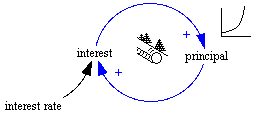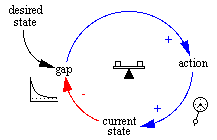Urie Bronfenbrenner's Ecoglogical Systems Theory
What Gene Bellinger and Lee Arnold have done is synthesized knowledge and built models, which can then be used by others. The atomization of information is part of the current problem, living in "the information age" thus the task of ST, in my view is synthesis, organization, coherency. Taking complexity and organizing or arranging so the whole and parts can be understood together. This is also why Derek Cabrera's model is so popular, he provides 4 categories for explaining what ST is all about. Fritjof Capra's current model also uses 4 categories (biological, cognitive, social, ecological) to help frame our thinking about human systems and transactions with the environment
http://www.systems-thinking.org/intst/int.htm
Introduction to Systems Thinking
People, when initially introduced to structures, also referred to as Archetypes, often find them a bit overwhelming. They really aren't at all difficult once you get used to them. The following is an introduction to structures and how to read the stories associated with the diagrams.
The basic idea of structure(s) is to point out the influence one thing has on another. That is, how do things influence other things to change.
If I have two things, thing 1 and thing 2, there are only two ways thing1 can influence thing2.
|
Figure 1: Add Relationship
As indicated in Figure 1, thing 1 can add to thing 2, as indicated by a "+" sign, thus increasing thing 2.
|
Figure 2: Subtract Relationship
The alternative is that thing 1 can subtract from thing 2, as indicated by the "-" sign in Figure 2, thus decreasing thing 2.
All this thingness may a bit difficult to connect with so let's consider a couple specific examples.
|
Figure 3: Sales Increases Revenue
Figure 3 indicates that sales adds to revenue. Even if sales decrease it will still add to revenue, just not quite as rapidly as before. On the other hand, if sales increases it will add even more readily to revenue.
|
 Figure 4: Product Sales and Inventory Figure 4: Product Sales and Inventory
Figure 4 indicates that product sales subtracts from finished goods inventory. If product sales increase it will subtract even more from finished goods inventory. On the other hand, if product sales decrease it will still subtract from finished goods inventory, just not quite so much.
Within systems diagrams there are often items that are held constant within the context of what is being considered. These items will have neither a "+" nor a "-" attached to them.
|
 Figure 5: Constant Contribution Figure 5: Constant Contribution
Figure 5 indicates that resources interact with productivity in such as way as to add to the finished goods inventory. The indication is that resources is a constant within the structure being considered so it neither adds to nor subtracts from, it just is. You might think of a constant as a catalyst for the result. If productivity increases it will interact with resources and add even more to finished goods inventory. If productivity decreases it will still interact with resources to add to finished goods inventory, just not so readily.
Now that we've covered connections, let's cover connections that complete to form loops. There are only two types of loops, reinforcing and balancing.
|
Reinforcing Loop
A reinforcing loop is one in which the interactions are such that each action adds to the other. Any situation where action produces a result which promotes more of the same action is representative of a reinforcing loop.
 Figure 6: Reinforcing Loop
Figure 6: Reinforcing Loop
Figure 6 indicates what happens in a typical savings account. The principal in the savings account interacts with the interest rate and adds to the interest. Note that interest rate is considered to be a constant in this example. Interest then adds to the principal. This reinforcing action happens every so many months depending on the period over which the institution computes the interest. The snowball rolling down hill is your signal that the loop is a reinforcing loop. The small graph to the right of principle indicates that the growth of principal is exponential.
Typical examples of reinforcing loops are population growth and decline, uncontrolled nuclear reactions, snow balls rolling down hill of course, runs on banks, wall street market crashes, etc.
Balancing Loop
A balancing loop is one in which action attempts to bring two things to agreement. Any situation where one attempts to solve a problem or achieve a goal or objective is representative of a balancing loop.
 Figure 7: Balancing Loop
Figure 7: Balancing Loop
Figure 7 provides the basic form of the balancing loop. The desired state interacts with the current state to produce a gap. The gap adds to the action and the action adds to the current state. The current state then subtracts from the gap. The small clock to the right of the arc between action and current state indicates some time delay that it takes for the action to change the current state. As the current state gets closer to the desired state the gap gets smaller and smaller so it adds less and less to the action, which is adding to the current state. Once the action has moved the current state to a point where it equals the desired state the gap is zero and there's no more addition to the action, so there is no more action. The balance in the center of the loop is your indication that the loop is a balancing loop.
Typical examples of balancing loops are driving from location A to location B, developing a skill, building something, fixing a problem, etc.
Telling one Loop from Another
Initially you might consider it difficult to figure out one loop from the other, yet it's simply a matter of counting. All you need to do is count the number of minus signs around the loop. If there is an even number, or zero, minus signs then it is a reinforcing loop. If there is an odd number of minus signs then it's a balancing loop.
These two loops can combine in numerous ways resulting in typical situation characteristics we recognize in our daily lives. theWay of Systems matches situation descriptions to common combinations of reinforcing and balancing loops which have very distinct characteristics.
Now that wasn't so tough, was it? You may have been expecting there was more to it than this, yet there really isn't. When one thing affects another thing it can only add to or subtract from that which it affects, otherwise there would be no influence at all now would there.
Systems Thinking: An Operational Perspective of the Universe provides a more elaborate background than this initial introduction though theWay of Systems presents a more integrated view of the archetypes. Also, George Richardson's "Problems with causal-loop diagrams" is a marvelous read.
theWay of Systems * Feedback * Musings
Figure 2: Subtract Relationship
The alternative is that thing 1 can subtract from thing 2, as indicated by the "-" sign in Figure 2, thus decreasing thing 2.
All this thingness may a bit difficult to connect with so let's consider a couple specific examples.
Links
See Also
Subcategories
``M
Pages
`
An Invitation to Systems Thinking: An Opportunity to Act for Systemic Change
Pages in Other Languages
Categories
Comments (1)
skreutzer said
at 9:15 pm on Feb 7, 2019
And I think this is a more or less misleading way to look at systems thinking, which has its roots in 70s/80s style of building models and simulations for projecting climate change, and that together with cybernetics "failed" in a sense and has therefore be abandoned since then. Or, let's say it differently: there are issues with the notion of system dynamics, which are presented here and by the book the supposed core of systems thinking. Me lacking any formal introduction to systems thinking and instead arriving at it from applied practice, suggest therefore that we should rather look at tools/methods of systems thinking, and be only secondarily concerned with this kind of system dynamics and modeling feedback loops and simulations, etc.
You don't have permission to comment on this page.